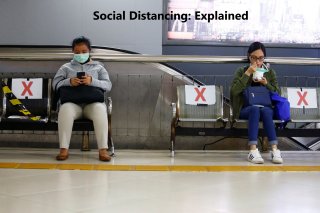How Social Distancing Can Save Millions of Lives (If Done Right)
If these policies are followed, the spread of the coronavirus can be contained, and the disease more easily eradicated. Here is what you need to know.
Despite his earlier indications that he would recommend the end of social distancing measures by Easter, U.S. President Donald Trump announced that he would be extending guidelines for another month, until April 30. This is in response to the coronavirus pandemic, of which 142,000 positive cases have been reported in the United States. "The better you do, the faster this whole nightmare will end," Trump said, tripling his preferred shutdown time of two-weeks.
As the United States prepares for at least another month of social distancing, it’s important that Americans get an understanding of the Do’s and Don’ts, along with why they help contain the coronavirus. “Social distancing is deliberately increasing the physical space between people to avoid spreading illness. Staying at least six feet away from other people lessens your chances of catching COVID-19,” explains Lisa Maragakis, M.D., senior director of infection prevention at John Hopkins University.
The coronavirus can spread through an infected person touching their mouth or nose, and with the germs still on their hands, touching someone else, who then touches their face. The virus can also survive several hours on surfaces, making it possible to transfer the disease if two people touch the same thing without ever coming into physical contact themselves. While the virus is not airborne, infected people carry an active form of it in their throats, which they can breathe onto others. This is why keeping a six-foot distance is necessary.
Social distancing is why large public events, including sports, theater, and music concerts have been canceled. Having large groups of people together, interacting, increases the likelihood that people who are already infected with the virus will spread it to others.
For social distancing to be effective, however, it also involves practicing it in your professional life as well. Many companies have instituted policies for employees to work from home, if it’s possible. Other companies who are unable to operate outside of the workplace have temporarily closed for the duration of the public health crisis.
But maybe most importantly, individuals have to enact social distancing in their personal life as well. This means avoiding going out unless it’s an absolute necessity, such as grocery shopping, caring for a loved one, or going to a doctor’s appointment. And even on these exceptions, remaining six feet away from other people. On a temporary basis, people should avoid parties or social gatherings that extend beyond the people they live with.
If these policies are followed, the spread of the coronavirus can be contained, and the disease more easily eradicated.
"We can expect that by June 1st, we will be well on our way to recovery, we think by June 1st. A lot of great things will be happening," Trump said yesterday. "I want our life back again.”
Hunter DeRensis is a senior reporter for the National Interest. Follow him on Twitter @HunterDeRensis.

